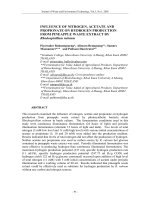lichens and vines on trees
Bạn đang xem bản rút gọn của tài liệu. Xem và tải ngay bản đầy đủ của tài liệu tại đây (1.94 MB, 6 trang )
Lichens and Vines
on Trees
SP660
Wayne K. Clatterbuck, Associate Professor
Forestry, Wildlife & Fisheries
Alan S. Windham, Professor
Entomology and Plant Pathology
Lichens
Are lichens really responsible for branch dieback and
plant death? A lichen is an autotrophic (meaning it has the
ability to produce organic material from inorganic chemi-
cals and a source of energy, the sun), symbiotic organism
composed of green algae or blue-green algae (cyanobacte-
ria) and fungal tissue. There is some debate on the nature
of this relationship, but most agree the alga and the fungus
both benefit from this arrangement. The alga manufactures
sugar that the fungus can live from and in return the fungus
provides protection to the alga. Lichens do not have roots,
stems and leaves, so they absorb most of their nutrients
from rainfall.
Lichens can be found almost anywhere worldwide.
They grow readily on rock, soil, processed wood and trees.
Foliose or leafy lichen
Alan Windham
Fructiose or shrubby lichen
Alan Windham
Ex
tension
2
They grow on constructed structures and even on
organisms such as tortoises and weevils. Lichens are found
in forests, the tundra, deserts, in tree canopies of tropical
rain forests, on mountains and rocky shores. Lichens are
able to withstand harsh conditions such as freezing, thaw-
ing, high light and intense heat. They are able to dry out
for long periods, then quickly become active again when
rehydrated.
Some other characteristics of lichens are that they
are slow to evolve and slow to grow. Most forms grow only
a few millimeters a year. Lichens are classified into three
major types of communities, as well as three morphologi-
cal groups. The three major communities are corticolous,
which grow on tree bark; terricolous, which grow on soil;
and saxicolous, which grow on rocks. The three morpho-
logical groups are fruticose (shrubby) lichens, foliose (leafy)
lichens and crustose (crusty) lichens.
Lichens play very significant roles in our biological
world. Lichens act as air pollution indicators. Some fruticose
types are used as indicators of unpolluted areas, while others
are able to withstand high levels of pollution. Since lichens
lack roots, nutrients that are dissolved in water are obtained
through surface absorption of rainfall. Lichens act much
like sponges, absorbing everything that is dissolved in the
rainwater and retaining it. Since there is no means of purg-
ing antagonistic substances, these substances accumulate in
the lichen and reach a level where they break down the chlo-
rophyll molecules that are responsible for photosynthesis of
the algae. Photosynthesis is the process green plants use to
convert sunlight energy to chemical energy, which is used in
the maintenance and growth of the plant. All lichens contain
green chlorophyll, although other substances or pigments on
the surface may make them appear gray, yellow or orange.
When the photosynthetic process stops in the algae, the algae
die, which eventually leads to the death of the fungus.
Research has shown that lichens are not parasitic on
higher plants. However, their growth may increase due to
increased light levels when branches lose leaves and die.
Lichens are not the cause of branch dieback and tree death.
Keep searching for other tree stressors that may be causing
these problems.
Sources
Brodo, I.M., S.D. Sharnoff and S. Sharnoff. 2001.
Lichens
of North America
. Yale University Press, New Haven,
CT. 795 p.
Hutchinson, J., D Maynard and L. Geiser. 1996.
Air qual-
ity and lichens – a literature review emphasizing the
Pacific Northwest
, USA. Portland, OR: U.S. Department
of Agriculture, Forest Service, Pacific Northwest Region
6, Pacific Northwest Region Air Resource Management
Program (www.fs.fed.us/r6/aq/lichen/almanac.html)
Vines
Vines are plants that cannot remain freestanding to
any appreciable height. They must climb by using other
plants or structures for support. Vines often use trees for
support. What effect do vines have on trees?
Vines climb on trees using four mechanisms (Figure
1): twining, tendrils, tendrils with adhesive disks and aerial
roots. Twining vines climb by encircling or winding around
upright supports such as trees and poles. Wisteria, some hon-
eysuckles, kudzu and bittersweets are a few vines that twine.
These vines can be detrimental to growth of young trees by
wrapping tightly around the tree stem. When the tree trunk
grows and expands, the vine constricts the flow of water and
food. Often the tree is girdled and eventually dies.
Winding vines climb by means of tendrils. The ten-
drils are slim, flexible and leafless stems that wrap around
most anything they contact, such as small branches and
twigs. The tendrils are relatively short-lived before wither-
ing and losing their grip, but by then the vine is higher in
the tree and growing new tendrils for support. Grapes are
an example of a climbing vine with tendrils.
Virginia creeper and crossvine also produce tendrils,
but their branched tips form flat disks with a sticky sub-
Wayne Clatterbuck
Lichens are common on tree trunks.
3
stance that adheres to the tree. Once the substance dries and
anchors the disk, the tendril coil contracts and draws the
vine closer to the tree.
Vines such as trumpet creeper, English ivy and poi-
son ivy produce aerial roots that attach to the tree. These
aerial roots do not absorb water or nutrients (all vines have
root systems in the ground) and thus do not harm the tree
or supporting surface. However, the vine and its aerial roots
may cause discoloration of the supporting surface (bricks,
mortar and non-living wood) by preventing air circulation,
which results in altered temperature and moisture condi-
tions. Wood decay might be promoted on non-living wood
surfaces. The aerial roots are difficult to remove from the
supporting surface once they have been anchored.
The fastest growing vines are stem twiners and tendril
climbers and the slowest are the root climbers. Most twiners
and tendril climbers must have support surfaces at different
canopy levels (either lower branches or different strata of
trees) to reach the top of the tree canopy. These climbers
cannot reach the upper canopy on isolated stems with high
branches without some lower support surface. Thus, most
twiners and tendril climbers grow with the tree as the tree
increases in height.
Figure 1. Climbing methods of vines.
(Adapted from Teramura and others, 1991).
Virginia creeper vine attached to a tree.
Wayne Clatterbuck
Wayne Clatterbuck
Honeysuckle vines encircling and girdling a small tree.
4
Vines of English ivy beginning to dominate a tree crown.
Notice that just a few branches of the upper crown are not
covered by the crown.
Wayne Clatterbuck
Native, exotic and invasive vines common in Tennessee
that use trees for support and their climbing method (shaded blocks).
Species
Common Name
Origin
Climbing Methods
Twining
Tendrils
Tendrils
with Disks
Aerial
Roots
Bignonia capreolata
Crossvine
Native
Campsis radicans
Trumpet Creeper
Native
Celastrus orbiculatis
Oriental Bittersweet
Exotic, Invasive
Celastrus scandens
American Bittersweet
Native
Decumaria barbara
Climbing Hydrangea
Native
Euonymus fortunei
Wintercreeper
Exotic, Invasive
Hedera helix
English Ivy
Exotic, Invasive
Lonicera japonica
Japanese Honeysuckle
Exotic, Invasive
Lonicera
spp.
Honeysuckle
Native & Exotic, Invasive
Species
Parthenocissus quinquefolia
Virginia Creeper
Native
Parthenocissus tricuspidata
Boston Ivy
Exotic
Pueraria lobata
Kudzu
Exotic, Invasive
Toxicodendron radicans
Poison Ivy
Native
Vitis
spp.
Grape
Native
Wisteria
spp.
Wisteria
Native & Exotic, Invasive
Species
Adapted from: Teramura and others, 1991
Adapted from: Teramura and others, 1991
Adapted from: Teramura and others, 1991
Most vines do not affect tree growth unless they grow
into the upper crown and canopy where their leaves displace
the leaves of the tree. The tree with fewer leaves and less
ability to photosynthesize will begin to decline as the vines
become more dominant. Vines that tend to be troublesome
in Tennessee include poison ivy, kudzu, wild grape, bit-
tersweet and honeysuckle. Vines should be severed at the
ground level and sprayed with a recommended herbicide
when cut or when they resprout.
Several vines are invasive exotics that colonize dis-
turbed areas and have the ability to climb to upper tree cano-
pies: Japanese honeysuckle, kudzu, English ivy and Oriental
bittersweet. These aggressive vines should be controlled
when encountered because they tend to spread across the
landscape unchecked and supplant native species.
Sources
Evans, E. 2000.
Vines of the Southeast. Plant Fact Sheets
.
Raleigh, NC: North Carolina State University, Depart-
ment of Horticultural Science (
ment of Horticultural Science (
w
ment of Horticultural Science (wment of Horticultural Science (
ww.ces.ncsu.edu/depts/
ww.ces.ncsu.edu/depts/
hort/consumer/factsheets/index.html
)
Teramura, A.H., W.G. Gold and I.N. Forseth. 1991.
Physi-
ological ecology of mesic, temperate woody vines
. Pages
245-285 in (F.E. Putz and H.A. Mooney, eds.) The Biol-
ogy of Vines. Cambridge University Press, Cambridge,
Great Britain.
5
Kudzu vines in trees.
Wayne Clatterbuck
Tendrils of a grapevine wrapping around each other.
Wayne Clatterbuck
Poison ivy vines with their aerial roots can be quite large.
Mike Williams
Wayne Clatterbuck
English ivy vines, when used as a ground cover, often climb
tree trunks.
T
E
N
N
E
S
S
E
E
D
E
P
A
R
T
M
E
N
T
O
F
A
G
R
I
C
U
L
T
U
R
E
F O R E S T R Y
D
E
P
A
R
T
M
E
N
T
O
F
A
G
R
I
C
U
L
T
U
R
E
F
O
R
E
S
T
S
E
R
V
I
C
E
U
S
6
SP660-15M-9/05 R12-4910-051-005-06 06-0070
Printing for this publication was funded by the USDA Forest Service through a grant with the Tennessee De part ment of Ag ri cul ture,
Division of Forestry. The Trees for Tennessee Landscapes series is sponsored by the Tennessee Urban Forestry Coun cil.
Wayne Clatterbuck
Flowers of the trumpet creeper vine.
Robin Bible
Programs in agriculture and natural resources, 4-H youth development, family and consumer sciences, and resource development.
University of Tennessee Institute of Agriculture, U.S. Department of Agriculture and county governments cooperating.
UT Extension provides equal opportunities in programs and employment.
Purple fl owers of wisteria, a twining vine.
Flowers of Japanese honeysuckle, an invasive vine.
Chuck Bargeron
Wayne Clatterbuck
Kudzu is a twining vine that supports itself by wrapping
around small branches. These vines cannot reach the upper
canopy unless there is is a “vertical ladder” of different
canopy levels that allows the vine to climb.









